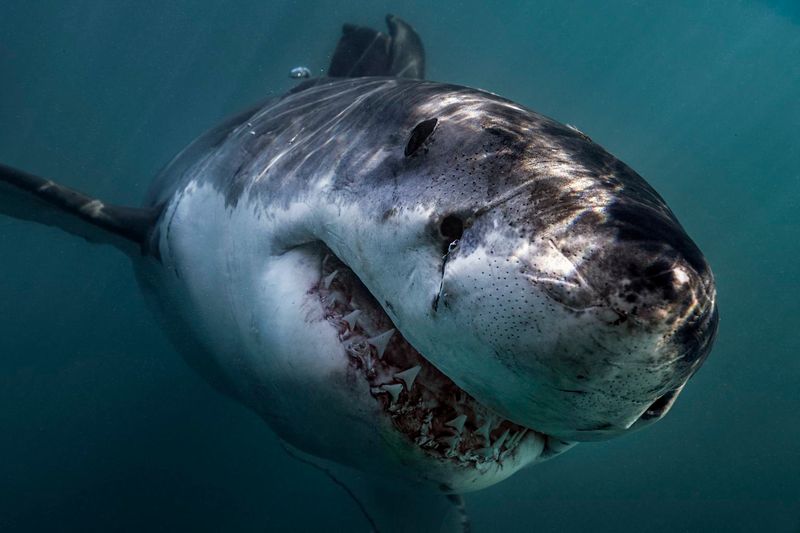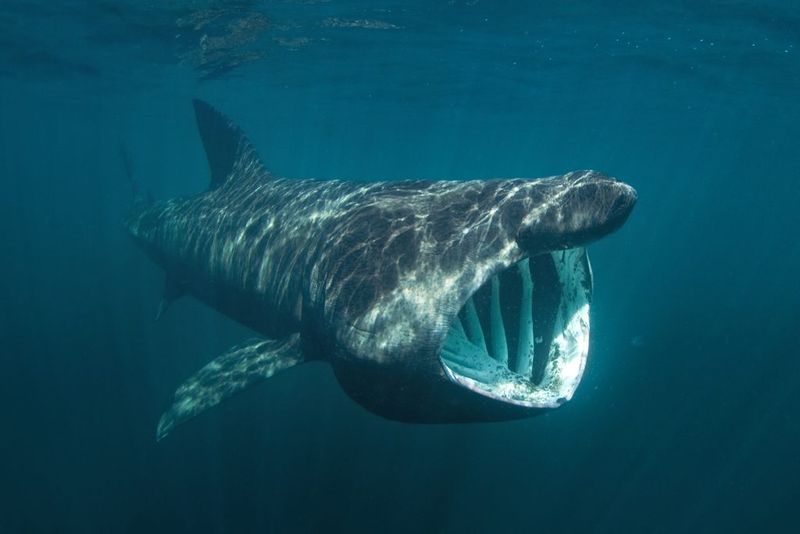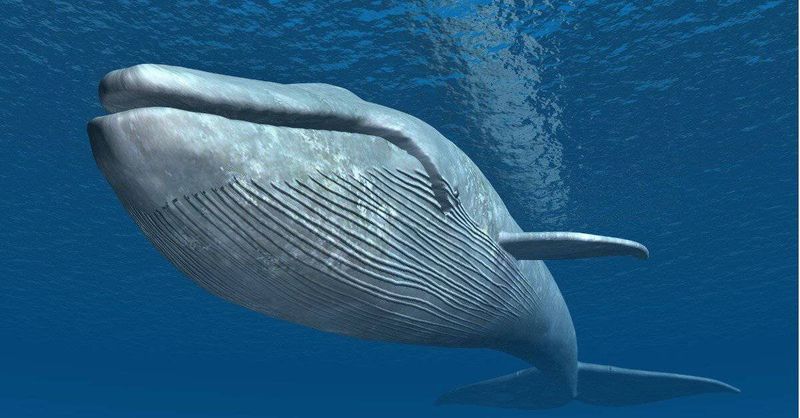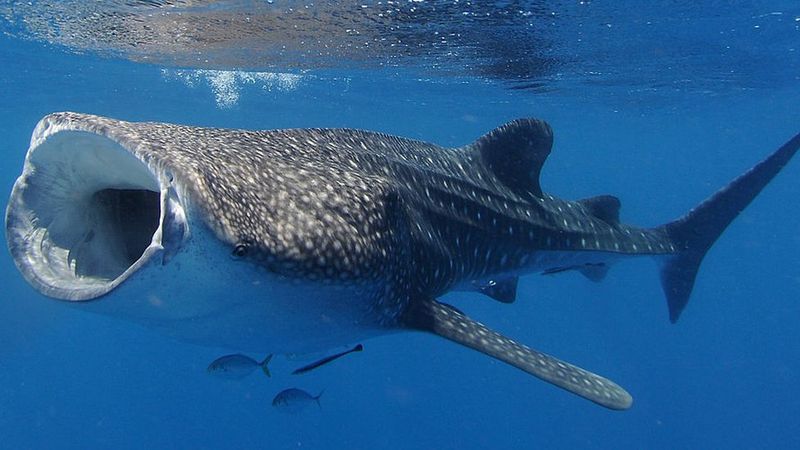Whale Shark Vs. Everything Else: How This Ocean Giant Measures Up

The whale shark – a spotted, gentle giant that roams our oceans – holds the title of largest fish on Earth. These massive creatures can grow up to 40 feet long and weigh as much as 20 tons, yet they feed primarily on tiny plankton.
How do these enormous fish stack up against other giants of the natural world and human-made creations? Let’s explore just how impressive these ocean behemoths truly are.
Whale Sharks: The Largest Fish In The Ocean

Imagine swimming alongside a creature the length of a school bus, with a mouth nearly five feet wide, yet feeling completely safe. That’s the whale shark experience.
These magnificent creatures typically grow 18-32 feet long, though the largest reliably measured was a whopping 41.5 feet! Despite their imposing size, they’re filter feeders with throats only the size of a quarter.
Their spotted pattern is completely unique – like a fingerprint – making each whale shark identifiable to researchers. They’re also incredibly long-lived, with lifespans estimated at 80-130 years, making them one of the longest-living vertebrates on our planet.
Whale Shark Vs. Great White: Who’s The Real King Of The Sharks?

Size clearly separates these ocean titans. While the great white tops out around 20 feet and 4,500 pounds, whale sharks can triple that length and weigh ten times more!
Their feeding habits couldn’t be more different. Great whites are apex predators with rows of serrated teeth for tearing flesh. Whale sharks? They’re gentle giants that filter-feed on plankton and small fish, lacking the fearsome dentition of their carnivorous cousins.
Swimming speed favors the hunter – great whites can burst at 35 mph, while whale sharks cruise leisurely at about 3 mph. Though both magnificent, the whale shark claims the size crown while the great white wears the predator’s crown.
Whale Shark Vs. Basking Shark: A Battle Of The Filter-Feeding Giants

Two gentle giants, both filter feeders, but with key differences. Whale sharks claim first place in the size competition – reaching up to 40 feet compared to the basking shark’s still-impressive 33 feet.
Their appearance sets them apart too. Whale sharks sport their iconic white-spotted pattern on a blue-gray background, while basking sharks wear a uniform gray-brown coat. The whale shark’s mouth sits at the front of its head, perfect for forward swimming and feeding, whereas the basking shark’s massive mouth extends around its snout.
Feeding techniques differ slightly: whale sharks actively suck in water to filter food, while basking sharks simply swim with mouths agape, letting water flow through their gill rakers.
Whale Shark Vs. Blue Whale: How Close Does It Get To The Biggest Of All?

The blue whale dwarfs even the mighty whale shark. At up to 100 feet long and weighing 200 tons, the blue whale is more than twice the length and ten times the weight of the largest whale shark ever recorded!
Both are filter feeders, but with different approaches. Whale sharks use their 300+ rows of tiny teeth to filter plankton, while blue whales employ massive baleen plates to strain krill from the water. The blue whale’s heart alone is the size of a small car – something no fish, not even the whale shark, can match.
Despite being outclassed in size, whale sharks still hold the impressive title of largest fish, while blue whales reign as the largest animals ever to exist on Earth.
Whale Shark Vs. African Elephant: Ocean Bulk Meets Land Muscle

The ocean’s largest fish faces off against the land’s largest mammal! Weight-wise, they’re surprisingly comparable – a full-grown whale shark at 20 tons narrowly edges out the African elephant’s 13-ton maximum.
Length tells a different story. Whale sharks stretch up to 40 feet, while even the largest elephants reach only about 13 feet from trunk to tail. African elephants make up for their shorter length with their impressive 13-foot height at the shoulder.
Both animals share surprising similarities: gentle dispositions despite their size, endangered status, and similar lifespans of 70+ years. The biggest difference? One needs water to support its massive body, while the other carries its weight on four tree-trunk legs across the African savanna.
Whale Shark Vs. School Bus: Which One’s Longer, Wider, And Heavier?

The classic yellow school bus serves as a perfect everyday reference for the whale shark’s incredible size. An average school bus stretches about 35 feet long – roughly the same as a typical adult whale shark, though record-breaking specimens can reach over 40 feet!
Width comparison favors the bus at about 8 feet across, while whale sharks measure 7-8 feet at their widest point. Where the fish truly outclasses the vehicle is in weight – a fully loaded school bus weighs around 15 tons, while large whale sharks can tip the scales at 20+ tons.
Next time you see a school bus, imagine that same vehicle gliding effortlessly through ocean currents with a spotted pattern and a wide, filter-feeding mouth!
Whale Shark Vs. Human: Just How Tiny Are We In Comparison?

Standing next to a whale shark makes even the tallest humans feel miniature. The average adult human reaches about 5.5 feet tall – meaning you could stack seven people head-to-toe to match a 40-foot whale shark’s length!
Weight comparison is even more dramatic. At around 150 pounds, the average person is outweighed 267 times by a 20-ton whale shark. Even their mouths are massive – stretching nearly 5 feet wide, a whale shark could easily fit a person inside (though thankfully, they have no interest in doing so).
Despite this enormous size difference, humans remain the greater threat in this relationship. Whale sharks face population decline due to fishing practices, vessel strikes, and habitat loss – reminding us that size doesn’t always determine vulnerability.
Whale Shark Vs. Humpback Whale: Gentle Giants With Different Moves

Both are ocean giants with peaceful personalities, but they’re built quite differently. Humpback whales typically reach 45-50 feet – slightly longer than the average whale shark’s 40 feet – but with a more robust build weighing up to 40 tons, double the whale shark’s weight.
Their movement styles couldn’t be more different. Whale sharks glide with subtle side-to-side tail motions, rarely breaching the surface. Humpbacks, famous for their acrobatic displays, launch their massive bodies entirely out of the water in spectacular breaches.
Communication sets them worlds apart too. Whale sharks are silent swimmers, while humpbacks produce the ocean’s most complex songs – haunting melodies that can last 20 minutes and travel for miles underwater.
Whale Shark Vs. Semi Truck: A Highway Hauler Meets A Sea Cruiser

Those massive semi trucks rumbling down highways provide a surprisingly good size comparison for whale sharks. An average tractor-trailer combination stretches about 70-80 feet long – nearly twice the length of even the largest whale sharks at 40+ feet.
Weight tells a different story. A fully loaded semi can weigh up to 40 tons, while large whale sharks typically max out around 20 tons. The truck distributes this weight across 18 wheels, while the shark’s mass is supported by the buoyancy of seawater.
Both are built for efficiency in their environments – the truck’s aerodynamic design cuts through air resistance on highways, while the whale shark’s streamlined body glides effortlessly through ocean currents with minimal energy expenditure.
Whale Shark Vs. Tyrannosaurus Rex: Jurassic Predator Vs. Modern Titan

The fearsome T. rex dominated the Cretaceous landscape, but how would it measure up against our modern ocean giant? Size-wise, the whale shark claims victory – stretching up to 40 feet compared to T. rex’s 40-foot maximum, but with a much bulkier build weighing up to 20 tons versus the dinosaur’s estimated 9 tons.
Their feeding strategies reflect opposite evolutionary paths. T. rex was the ultimate land predator with bone-crushing jaws exerting 8,000 pounds of force. The whale shark, despite its size, feeds on some of the ocean’s smallest creatures through gentle filter-feeding.
One similarity? Both represent evolutionary success stories – T. rex ruled for 2 million years, while whale sharks have patrolled our oceans for over 60 million years!
Whale Shark Vs. Submarine: Can Nature Outsize Human Engineering?

Modern military submarines like the Ohio-class measure around 560 feet long – dwarfing even the largest whale sharks at 40+ feet. The submarine’s 18,000-ton displacement similarly overshadows the whale shark’s 20-ton maximum weight.
Their depth capabilities show interesting contrasts. Whale sharks typically cruise in the upper 200 feet of ocean but can dive to nearly 6,000 feet when needed. Modern submarines can operate at depths exceeding 800 feet, with specialized deep-sea research vessels reaching much greater depths.
Speed comparison favors human engineering – submarines can cruise at 20+ knots (23 mph), while whale sharks maintain a leisurely pace of about 3 mph. Nature’s design excels in efficiency though – whale sharks operate silently without fuel, while submarines require nuclear or diesel power plants.
Whale Shark Vs. House: Would One Even Fit In Your Backyard?

Picturing a whale shark next to your home provides a startling size perspective. The average American single-family home measures about 2,500 square feet with dimensions roughly 50 feet by 50 feet – making it wider but shorter than a full-grown whale shark at 40 feet long.
Ceiling heights in modern homes typically reach 9 feet – taller than a whale shark’s maximum girth of about 7-8 feet. Your swimming pool? Unless it’s Olympic-sized, it’s probably too small for this ocean giant, which requires thousands of gallons of water.
Weight presents the biggest challenge – at 20+ tons, a whale shark would likely crush your foundation! This comparison shows why these magnificent creatures belong in the vast ocean rather than your backyard.






